[English] 日本語
 Yorodumi
Yorodumi- EMDB-33792: Structure of GluN1a-GluN2D NMDA receptor in complex with agonists... -
+ Open data
Open data
- Basic information
Basic information
| Entry |  | ||||||||||||||||||
|---|---|---|---|---|---|---|---|---|---|---|---|---|---|---|---|---|---|---|---|
| Title | Structure of GluN1a-GluN2D NMDA receptor in complex with agonists glycine and glutamate. | ||||||||||||||||||
 Map data Map data | |||||||||||||||||||
 Sample Sample |
| ||||||||||||||||||
 Keywords Keywords |  ion channel / cryo-EM structure / ion channel / cryo-EM structure /  glutamate receptor / synaptic protein / glutamate receptor / synaptic protein /  ELECTRON TRANSPORT ELECTRON TRANSPORT | ||||||||||||||||||
| Function / homology |  Function and homology information Function and homology informationexcitatory chemical synaptic transmission / regulation of sensory perception of pain / Synaptic adhesion-like molecules / cellular response to L-glutamate / propylene metabolic process / response to glycine / voltage-gated monoatomic cation channel activity / glutamate-gated calcium ion channel activity / regulation of monoatomic cation transmembrane transport / Assembly and cell surface presentation of NMDA receptors ...excitatory chemical synaptic transmission / regulation of sensory perception of pain / Synaptic adhesion-like molecules / cellular response to L-glutamate / propylene metabolic process / response to glycine / voltage-gated monoatomic cation channel activity / glutamate-gated calcium ion channel activity / regulation of monoatomic cation transmembrane transport / Assembly and cell surface presentation of NMDA receptors / Neurexins and neuroligins /  NMDA glutamate receptor activity / NMDA selective glutamate receptor complex / calcium ion transmembrane import into cytosol / protein heterotetramerization / NMDA glutamate receptor activity / NMDA selective glutamate receptor complex / calcium ion transmembrane import into cytosol / protein heterotetramerization /  glutamate binding / positive regulation of reactive oxygen species biosynthetic process / glutamate binding / positive regulation of reactive oxygen species biosynthetic process /  glycine binding / positive regulation of calcium ion transport into cytosol / Negative regulation of NMDA receptor-mediated neuronal transmission / glycine binding / positive regulation of calcium ion transport into cytosol / Negative regulation of NMDA receptor-mediated neuronal transmission /  startle response / Unblocking of NMDA receptors, glutamate binding and activation / regulation of neuronal synaptic plasticity / monoatomic cation transmembrane transport / positive regulation of excitatory postsynaptic potential / startle response / Unblocking of NMDA receptors, glutamate binding and activation / regulation of neuronal synaptic plasticity / monoatomic cation transmembrane transport / positive regulation of excitatory postsynaptic potential /  Long-term potentiation / monoatomic cation transport / ligand-gated monoatomic ion channel activity / Long-term potentiation / monoatomic cation transport / ligand-gated monoatomic ion channel activity /  excitatory synapse / calcium ion homeostasis / glutamate-gated receptor activity / excitatory synapse / calcium ion homeostasis / glutamate-gated receptor activity /  synaptic cleft / presynaptic active zone membrane / ligand-gated monoatomic ion channel activity involved in regulation of presynaptic membrane potential / EPHB-mediated forward signaling / synaptic cleft / presynaptic active zone membrane / ligand-gated monoatomic ion channel activity involved in regulation of presynaptic membrane potential / EPHB-mediated forward signaling /  excitatory postsynaptic potential / hippocampal mossy fiber to CA3 synapse / excitatory postsynaptic potential / hippocampal mossy fiber to CA3 synapse /  regulation of membrane potential / ionotropic glutamate receptor signaling pathway / Ras activation upon Ca2+ influx through NMDA receptor / positive regulation of synaptic transmission, glutamatergic / adult locomotory behavior / transmitter-gated monoatomic ion channel activity involved in regulation of postsynaptic membrane potential / regulation of membrane potential / ionotropic glutamate receptor signaling pathway / Ras activation upon Ca2+ influx through NMDA receptor / positive regulation of synaptic transmission, glutamatergic / adult locomotory behavior / transmitter-gated monoatomic ion channel activity involved in regulation of postsynaptic membrane potential /  synaptic membrane / synaptic membrane /  synaptic transmission, glutamatergic / long-term synaptic potentiation / postsynaptic density membrane / synaptic transmission, glutamatergic / long-term synaptic potentiation / postsynaptic density membrane /  brain development / brain development /  regulation of synaptic plasticity / regulation of synaptic plasticity /  visual learning / visual learning /  terminal bouton / terminal bouton /  synaptic vesicle / synaptic vesicle /  signaling receptor activity / signaling receptor activity /  amyloid-beta binding / chemical synaptic transmission / RAF/MAP kinase cascade / amyloid-beta binding / chemical synaptic transmission / RAF/MAP kinase cascade /  postsynaptic membrane / response to ethanol / postsynaptic membrane / response to ethanol /  dendritic spine / dendritic spine /  postsynaptic density / postsynaptic density /  calmodulin binding / neuron projection / calmodulin binding / neuron projection /  dendrite / dendrite /  synapse / glutamatergic synapse / synapse / glutamatergic synapse /  calcium ion binding / protein-containing complex binding / endoplasmic reticulum membrane / calcium ion binding / protein-containing complex binding / endoplasmic reticulum membrane /  cell surface / positive regulation of transcription by RNA polymerase II / cell surface / positive regulation of transcription by RNA polymerase II /  plasma membrane / plasma membrane /  cytoplasm cytoplasmSimilarity search - Function | ||||||||||||||||||
| Biological species |   Homo sapiens (human) Homo sapiens (human) | ||||||||||||||||||
| Method |  single particle reconstruction / single particle reconstruction /  cryo EM / Resolution: 3.9 Å cryo EM / Resolution: 3.9 Å | ||||||||||||||||||
 Authors Authors | Zhang JL / Zhu SJ / Zhang M | ||||||||||||||||||
| Funding support |  China, 5 items China, 5 items
| ||||||||||||||||||
 Citation Citation |  Journal: Nat Struct Mol Biol / Year: 2023 Journal: Nat Struct Mol Biol / Year: 2023Title: Distinct structure and gating mechanism in diverse NMDA receptors with GluN2C and GluN2D subunits. Authors: Jilin Zhang / Ming Zhang / Qinrui Wang / Han Wen / Zheyi Liu / Fangjun Wang / Yuhang Wang / Fenyong Yao / Nan Song / Zengwei Kou / Yang Li / Fei Guo / Shujia Zhu /  Abstract: N-methyl-D-aspartate (NMDA) receptors are heterotetramers comprising two GluN1 and two alternate GluN2 (N2A-N2D) subunits. Here we report full-length cryo-EM structures of the human N1-N2D di- ...N-methyl-D-aspartate (NMDA) receptors are heterotetramers comprising two GluN1 and two alternate GluN2 (N2A-N2D) subunits. Here we report full-length cryo-EM structures of the human N1-N2D di-heterotetramer (di-receptor), rat N1-N2C di-receptor and N1-N2A-N2C tri-heterotetramer (tri-receptor) at a best resolution of 3.0 Å. The bilobate N-terminal domain (NTD) in N2D intrinsically adopts a closed conformation, leading to a compact NTD tetramer in the N1-N2D receptor. Additionally, crosslinking the ligand-binding domain (LBD) of two N1 protomers significantly elevated the channel open probability (Po) in N1-N2D di-receptors. Surprisingly, the N1-N2C di-receptor adopted both symmetric (minor) and asymmetric (major) conformations, the latter further locked by an allosteric potentiator, PYD-106, binding to a pocket between the NTD and LBD in only one N2C protomer. Finally, the N2A and N2C subunits in the N1-N2A-N2C tri-receptor display a conformation close to one protomer in the N1-N2A and N1-N2C di-receptors, respectively. These findings provide a comprehensive structural understanding of diverse function in major NMDA receptor subtypes. | ||||||||||||||||||
| History |
|
- Structure visualization
Structure visualization
| Supplemental images |
|---|
- Downloads & links
Downloads & links
-EMDB archive
| Map data |  emd_33792.map.gz emd_33792.map.gz | 34.5 MB |  EMDB map data format EMDB map data format | |
|---|---|---|---|---|
| Header (meta data) |  emd-33792-v30.xml emd-33792-v30.xml emd-33792.xml emd-33792.xml | 21.8 KB 21.8 KB | Display Display |  EMDB header EMDB header |
| FSC (resolution estimation) |  emd_33792_fsc.xml emd_33792_fsc.xml | 9.3 KB | Display |  FSC data file FSC data file |
| Images |  emd_33792.png emd_33792.png | 38.7 KB | ||
| Masks |  emd_33792_msk_1.map emd_33792_msk_1.map | 67 MB |  Mask map Mask map | |
| Others |  emd_33792_half_map_1.map.gz emd_33792_half_map_1.map.gz emd_33792_half_map_2.map.gz emd_33792_half_map_2.map.gz | 61.8 MB 61.8 MB | ||
| Archive directory |  http://ftp.pdbj.org/pub/emdb/structures/EMD-33792 http://ftp.pdbj.org/pub/emdb/structures/EMD-33792 ftp://ftp.pdbj.org/pub/emdb/structures/EMD-33792 ftp://ftp.pdbj.org/pub/emdb/structures/EMD-33792 | HTTPS FTP |
-Related structure data
| Related structure data | 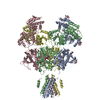 7yflMC 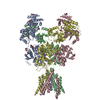 7yffC  7yfgC  7yfhC 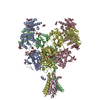 7yfiC 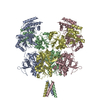 7yfmC  7yfoC  7yfrC  8hdkC C: citing same article ( M: atomic model generated by this map |
|---|---|
| Similar structure data | Similarity search - Function & homology  F&H Search F&H Search |
- Links
Links
| EMDB pages |  EMDB (EBI/PDBe) / EMDB (EBI/PDBe) /  EMDataResource EMDataResource |
|---|---|
| Related items in Molecule of the Month |
- Map
Map
| File |  Download / File: emd_33792.map.gz / Format: CCP4 / Size: 67 MB / Type: IMAGE STORED AS FLOATING POINT NUMBER (4 BYTES) Download / File: emd_33792.map.gz / Format: CCP4 / Size: 67 MB / Type: IMAGE STORED AS FLOATING POINT NUMBER (4 BYTES) | ||||||||||||||||||||
|---|---|---|---|---|---|---|---|---|---|---|---|---|---|---|---|---|---|---|---|---|---|
| Voxel size | X=Y=Z: 1.06 Å | ||||||||||||||||||||
| Density |
| ||||||||||||||||||||
| Symmetry | Space group: 1 | ||||||||||||||||||||
| Details | EMDB XML:
|
-Supplemental data
-Mask #1
| File |  emd_33792_msk_1.map emd_33792_msk_1.map | ||||||||||||
|---|---|---|---|---|---|---|---|---|---|---|---|---|---|
| Projections & Slices |
| ||||||||||||
| Density Histograms |
-Half map: #2
| File | emd_33792_half_map_1.map | ||||||||||||
|---|---|---|---|---|---|---|---|---|---|---|---|---|---|
| Projections & Slices |
| ||||||||||||
| Density Histograms |
-Half map: #1
| File | emd_33792_half_map_2.map | ||||||||||||
|---|---|---|---|---|---|---|---|---|---|---|---|---|---|
| Projections & Slices |
| ||||||||||||
| Density Histograms |
- Sample components
Sample components
-Entire : NMDA receptor with NMDA 1 incorperated with NMDA 2D
| Entire | Name: NMDA receptor with NMDA 1 incorperated with NMDA 2D |
|---|---|
| Components |
|
-Supramolecule #1: NMDA receptor with NMDA 1 incorperated with NMDA 2D
| Supramolecule | Name: NMDA receptor with NMDA 1 incorperated with NMDA 2D / type: complex / ID: 1 / Parent: 0 / Macromolecule list: #1-#2 |
|---|---|
| Source (natural) | Organism:   Homo sapiens (human) / Strain: Homo sapiens / Organ: brain / Tissue: brain / Organelle: synapse / Location in cell: plasma membrane Homo sapiens (human) / Strain: Homo sapiens / Organ: brain / Tissue: brain / Organelle: synapse / Location in cell: plasma membrane |
| Molecular weight | Theoretical: 384.54 kDa/nm |
-Macromolecule #1: Glutamate receptor ionotropic, NMDA 1
| Macromolecule | Name: Glutamate receptor ionotropic, NMDA 1 / type: protein_or_peptide / ID: 1 / Number of copies: 2 / Enantiomer: LEVO |
|---|---|
| Source (natural) | Organism:   Homo sapiens (human) Homo sapiens (human) |
| Molecular weight | Theoretical: 95.236078 KDa |
| Recombinant expression | Organism:   Homo sapiens (human) Homo sapiens (human) |
| Sequence | String: MSTMRLLTLA LLFSCSVARA ACDPKIVNIG AVLSTRKHEQ MFREAVNQAN KRHGSWKIQL NATSVTHKPN AIQMALSVCE DLISSQVYA ILVSHPPTPN DHFTPTPVSY TAGFYRIPVL GLTTRMSIYS DKSIHLSFLR TVPPYSHQSS VWFEMMRVYS W NHIILLVS ...String: MSTMRLLTLA LLFSCSVARA ACDPKIVNIG AVLSTRKHEQ MFREAVNQAN KRHGSWKIQL NATSVTHKPN AIQMALSVCE DLISSQVYA ILVSHPPTPN DHFTPTPVSY TAGFYRIPVL GLTTRMSIYS DKSIHLSFLR TVPPYSHQSS VWFEMMRVYS W NHIILLVS DDHEGRAAQK RLETLLEERE SKAEKVLQFD PGTKNVTALL MEAKELEARV IILSASEDDA ATVYRAAAML NM TGSGYVW LVGEREISGN ALRYAPDGIL GLQLINGKNE SAHISDAVGV VAQAVHELLE KENITDPPRG CVGNTNIWKT GPL FKRVLM SSKYADGVTG RVEFNEDGDR KFANYSIMNL QNRKLVQVGI YNGTHVIPND RKIIWPGGET EKPRGYQMST RLKI VTIHQ EPFVYVKPTL SDGTCKEEFT VNGDPVKKVI CTGPNDTSPG SPRHTVPQCC YGFCIDLLIK LARTMNFTYE VHLVA DGKF GTQERVNNSN KKEWNGMMGE LLSGQADMIV APLTINNERA QYIEFSKPFK YQGLTILVKK EIPRSTLDSF MQPFQS TLW LLVGLSVHVV AVMLYLLDRF SPFGRFKVNS EEEEEDALTL SSAMWFSWGV LLNSGIGEGA PRSFSARILG MVWAGFA MI IVASYTANLA AFLVLDRPEE RITGINDPRL RNPSDKFIYA TVKQSSVDIY FRRQVELSTM YRHMEKHNYE SAAEAIQA V RDNKLHAFIW DSAVLEFEAS QKCDLVTTGE LFFRSGFGIG MRKDSPWKQN VSLSILKSHE NGFMEDLDKT WVRYQECDS RSNAPATLTF ENMAGVFMLV AGGIVAGIFL IFIEIAYKRH KDARRKQ UniProtKB: Glutamate receptor ionotropic, NMDA 1 |
-Macromolecule #2: Glutamate receptor ionotropic, NMDA 2D
| Macromolecule | Name: Glutamate receptor ionotropic, NMDA 2D / type: protein_or_peptide / ID: 2 / Number of copies: 2 / Enantiomer: LEVO |
|---|---|
| Source (natural) | Organism:   Homo sapiens (human) Homo sapiens (human) |
| Molecular weight | Theoretical: 97.226414 KDa |
| Recombinant expression | Organism:   Homo sapiens (human) Homo sapiens (human) |
| Sequence | String: MRGAGGPRGP RGPAKMLLLL ALACASPFPE EAPGPGGAGG PGGGLGGARP LNVALVFSGP AYAAEAARLG PAVAAAVRSP GLDVRPVAL VLNGSDPRSL VLQLCDLLSG LRVHGVVFED DSRAPAVAPI LDFLSAQTSL PIVAVHGGAA LVLTPKEKGS T FLQLGSST ...String: MRGAGGPRGP RGPAKMLLLL ALACASPFPE EAPGPGGAGG PGGGLGGARP LNVALVFSGP AYAAEAARLG PAVAAAVRSP GLDVRPVAL VLNGSDPRSL VLQLCDLLSG LRVHGVVFED DSRAPAVAPI LDFLSAQTSL PIVAVHGGAA LVLTPKEKGS T FLQLGSST EQQLQVIFEV LEEYDWTSFV AVTTRAPGHR AFLSYIEVLT DGSLVGWEHR GALTLDPGAG EAVLSAQLRS VS AQIRLLF CAREEAEPVF RAAEEAGLTG SGYVWFMVGP QLAGGGGSGA PGEPPLLPGG APLPAGLFAV RSAGWRDDLA RRV AAGVAV VARGAQALLR DYGFLPELGH DCRAQNRTHR GESLHRYFMN ITWDNRDYSF NEDGFLVNPS LVVISLTRDR TWEV VGSWE QQTLRLKYPL WSRYGRFLQP VDDTQHLTVA TLEERPFVIV EPADPISGTC IRDSVPCRSQ LNRTHSPPPD APRPE KRCC KGFCIDILKR LAHTIGFSYD LYLVTNGKHG KKIDGVWNGM IGEVFYQRAD MAIGSLTINE ERSEIVDFSV PFVETG ISV MVARSNGTVS PSAFLEPYSP AVWVMMFVMC LTVVAVTVFI FEYLSPVGYN RSLATGKRPG GSTFTIGKSI WLLWALV FN NSVPVENPRG TTSKIMVLVW AFFAVIFLAS YTANLAAFMI QEEYVDTVSG LSDRKFQRPQ EQYPPLKFGT VPNGSTEK N IRSNYPDMHS YMVRYNQPRV EEALTQLKAG KLDAFIYDAA VLNYMARKDE GCKLVTIGSG KVFATTGYGI ALHKGSRWK RPIDLALLQF LGDDEIEMLE RLWLSGICHN DKIEVMSSKL DIDNMAGVFY MLLVAMGLSL LVFAWEHLVY WRLRHCLGPA ASAWSHPQF EK UniProtKB: Glutamate receptor ionotropic, NMDA 2D |
-Macromolecule #4: GLYCINE
| Macromolecule | Name: GLYCINE / type: ligand / ID: 4 / Number of copies: 2 / Formula: GLY |
|---|---|
| Molecular weight | Theoretical: 75.067 Da |
| Chemical component information | 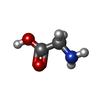 ChemComp-GLY: |
-Macromolecule #5: 2-acetamido-2-deoxy-beta-D-glucopyranose
| Macromolecule | Name: 2-acetamido-2-deoxy-beta-D-glucopyranose / type: ligand / ID: 5 / Number of copies: 10 / Formula: NAG |
|---|---|
| Molecular weight | Theoretical: 221.208 Da |
| Chemical component information |  ChemComp-NAG: |
-Macromolecule #6: GLUTAMIC ACID
| Macromolecule | Name: GLUTAMIC ACID / type: ligand / ID: 6 / Number of copies: 2 / Formula: GLU |
|---|---|
| Molecular weight | Theoretical: 147.129 Da |
| Chemical component information |  ChemComp-GLU: |
-Experimental details
-Structure determination
| Method |  cryo EM cryo EM |
|---|---|
 Processing Processing |  single particle reconstruction single particle reconstruction |
| Aggregation state | particle |
- Sample preparation
Sample preparation
| Concentration | 4.0 mg/mL |
|---|---|
| Buffer | pH: 8 |
| Grid | Model: Quantifoil R1.2/1.3 / Material: GOLD / Mesh: 300 / Pretreatment - Type: GLOW DISCHARGE / Pretreatment - Time: 60 sec. / Pretreatment - Atmosphere: AIR / Pretreatment - Pressure: 101.325 kPa |
| Vitrification | Cryogen name: ETHANE / Chamber humidity: 100 % / Chamber temperature: 281 K / Instrument: FEI VITROBOT MARK IV / Details: Blot for 3 seconds before plunging. |
| Details | This sample was monodisperse |
- Electron microscopy
Electron microscopy
| Microscope | FEI TITAN KRIOS |
|---|---|
| Electron beam | Acceleration voltage: 300 kV / Electron source:  FIELD EMISSION GUN FIELD EMISSION GUN |
| Electron optics | Illumination mode: FLOOD BEAM / Imaging mode: BRIGHT FIELD Bright-field microscopy / Nominal defocus max: 2.5 µm / Nominal defocus min: 1.5 µm Bright-field microscopy / Nominal defocus max: 2.5 µm / Nominal defocus min: 1.5 µm |
| Image recording | Film or detector model: DIRECT ELECTRON DE-10 (5k x 4k) / Detector mode: SUPER-RESOLUTION / Digitization - Frames/image: 1-40 / Number grids imaged: 1 / Number real images: 3840 / Average electron dose: 60.0 e/Å2 |
| Experimental equipment |  Model: Titan Krios / Image courtesy: FEI Company |
- Image processing
Image processing
-Atomic model buiding 1
| Initial model | PDB ID: Chain - Source name: PDB / Chain - Initial model type: experimental model |
|---|---|
| Refinement | Space: REAL / Protocol: FLEXIBLE FIT / Overall B value: 220 / Target criteria: Correlation coefficient |
| Output model |  PDB-7yfl: |
 Movie
Movie Controller
Controller





















 Z
Z Y
Y X
X



























